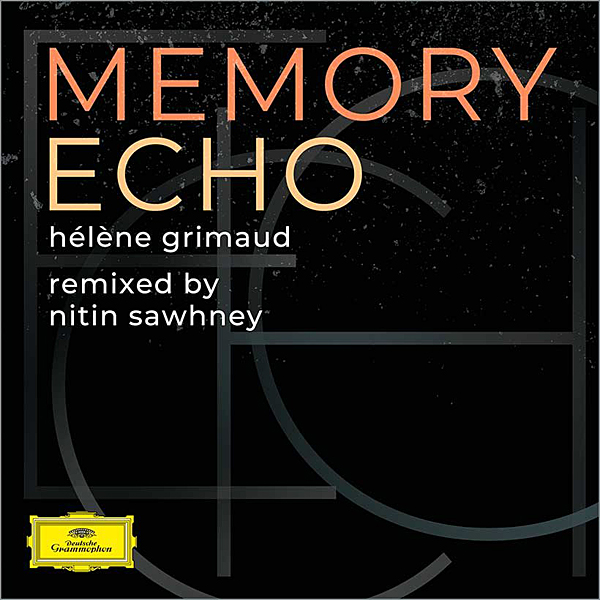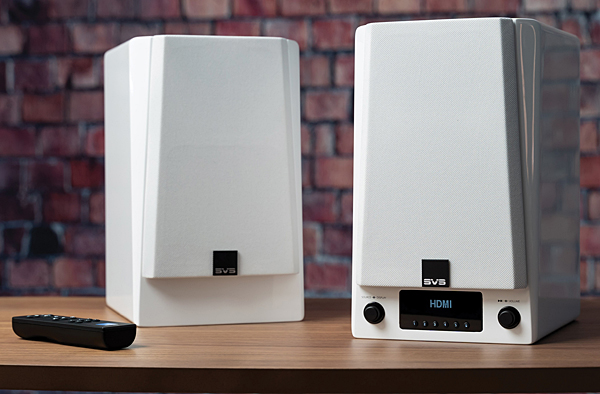| Columns Retired Columns & Blogs |
It looks like I have another speaker to recommend to friends who are 'just music-lovers'... Thanks!

That experience alleviated some audiophile anxiety. On my review roster, the Prime Pros followed Paradigm's Founder 120H speakers, which go down to 18Hz with abundant, room-filling bass. Following them up with the little SVS Prime Pro system, I'd expected to feel bass-deprived, but I needn't have worried. Although the SVS monitors only manage to pump out bass down to about 42Hz according to the specifications (at –3dB), the company's engineers tweaked that DSP-controlled crossover in a way that again reminded me of a clown car: How can all of that come out of something so small? I guess it makes sense: It stands to reason that SVS, which is known for its compact, high-quality subwoofers, would design speakers that go deep.
I dig the look of the Prime Pros, with their piano-gloss finish and those wedge-shaped bevels where the sides meet the front. (Known as chamfers, they lessen edge diffraction, which should result in clearer, more precise imaging.)
About that OLED display I mentioned: During my five-plus weeks of nightly fun with the Prime Pros, I could usually just make out from my listening chair the name of the song and the performer on the display on the front of the right speaker. You get scrolling track and artist names when streaming music over Wi-Fi. Using the optical, analog, or HDMI inputs, you see just the name of the input. The text on the two-line display is pretty jagged by today's smartphone standards (think dot-matrix printer, not laser), but it's serviceable. The importance of this is up for debate, I suppose; most buyers will probably use a hand-held or laptop screen that already provides song information.
Speaking of legibility, the six preset buttons I mentioned, on the active speaker's fascia, are each about the size of a deer tick: tiny (footnote 5). It took me weeks to realize that those backlit controls are in fact numbered 1 through 6 on the buttons themselves. I'm hardly Mister Magoo (footnote 6), but I thought the numbers were dots: That's how small the type is. That need not stand in the way of using the buttons, though. Even if you're in your favorite listening spot, you won't miss those front-panel controls because they're duplicated on the remote control that SVS includes. Handy.

Facing the music
The first album I played all the way through on the Prime Pros was Mahakali, the Music of Don Cherry (16/44.1, Tidal), seven spacey, frenetic tracks by French electrofunk pioneer Gary Gritness, based on tunes by the virtuoso of the tiny trumpet. I'd taken a shine to the recording because of its shimmering beats, synthesizers that evoke desert woodwinds, and mysterious, half-whispered vocals. There are all kinds of cool mixing-board tricks going on, including phase frippery that makes certain sounds appear to come from beyond the room boundaries and from behind and above the listening position. It's not so much hi-fi as oh-my-fi, an effort to loosen or at least mess with expectations of what a proper stereo recording should sound like.
It's especially rewarding to listen to it with nearfield monitors, which are superior at creating the illusion. Both on my desk and in my listening room, the Prime Pros did a sweet job painting this clearly artificial 3D space.

I intended to play just one or two tracks from System of a Down's Toxicity (16/44.1, Qobuz), but I enjoyed those brutal metal beats so much on the SVS speakers that I let the whole album roll by, blithely ditching my reviewing duties for the better part of an hour.
"Break," by rapper Beenzino (16/44.1, Tidal), is a kind of Korean "Lust for Life" (Iggy Pop): raucous drums and inexhaustible, bounce-off-the-walls energy. All the loud, lively material I played sounded excellent on the Prime Pros. They know how to party.
On "X-Race" by Yello (16/44.1, Tidal), the Formula One cars that roar across the room sounded smaller than on my reference system—hardly a surprise. But the chills of the down-tempo spy-thriller theme, which sounds like it was borrowed from John Barry's original James Bond score, came through intact. Scale was smaller, naturally, but everything sounded accurate, spacious, and involving.
Playing "The Snow Maiden" performed by the Minnesota Orchestra (16/44.1, Tidal) at neighbor-enraging levels yielded very good spatial cues. Dynamics fell short of what's possible, but they were sufficient to put a smile on my face. With the whole orchestra bursting forth into the room, the sonic picture was a bit more congested than I'm used to from my reference speakers, the five-times-as-expensive Tekton Moabs. There was less depth to the soundstage, but the width was very satisfying.
No sub-$1000 all-in-one system can attain anything close to perfection, but night after night the Prime Pros surprised me. When I reviewed the first-gen KEF LS50 wireless speakers, for another publication, I found they had trouble filling my listening room. With busy, complicated material by artists such as XTC and Frank Zappa, "the LS50Ws will play faithfully, but only if you settle for relatively polite volume levels," I wrote. "Turn the music up, way up, and you may find that the bass gets a bit anemic, and that both the midrange and treble take on a slightly glassy quality." Despite being physically smaller, the SVS Prime Pro Wireless system had no such issues. Even without a sub or two, they played loudly without breaking up or sounding ragged.
Sure, on bass-torture tracks like Two Feet's "Love Is a Bitch" (16/44.1, Qobuz), they betrayed limitations: the absence of the bottom octave can't be overcome no matter how good your DSP is. But I never thought, "Well, that's a shame." Instead, my brain said, as if on repeat, "That's actually damn good."

If I had to name a sonic shortcoming of the Prime Pros, it's imaging. Voices and instruments were often a pleasant wash of sound, not smeared, but lacking pinpoint precision. I wonder if the speakers' internal vibrations came into play: Even with the somber piano music of Hélène Grimaud—for instance, "Vocalise," Op.34 No.14, from the album Memory Echo (24/48 MQA/Tidal)—the SVS chassis proved less than inert. With Grimaud's delicate playing at dinner-conversation levels, I could place my hands on the sides of the cabinet and feel soundwaves buzzing outward. I'd already moved the speakers farther apart and closer together, forward and back, toed them in and pointed them straight ahead. Now I put some of my beloved doorstop weights (footnote 7) on top of them to damp the vibrations. Not bad, but never did everything quite click into place.
When I asked Gary Yacoubian about this, he parried that the Prime Pros' internal bracing "is FEA-optimized (footnote 8), with ample support and rigidity." The company says it checked my experience against that of its beta testers and dealers, who relayed that the Prime Pros are "as inert as any other powered speakers they've assessed." SVS offered to overnight a second pair of Prime Pros, but the company found they were in short supply. All testing, including measurements, is based on the original pair.
Summing up
It is the best of times, it is the worst of times. Inflation soars, yet bargains abound. For a knock-your-socks-off audiophile starter set or bedroom system, I remain completely enamored of the all-in-one Vanatoo Transparent One Encores I mentioned earlier. Their quasi-dinky looks belie their lavish high-end performance.
The SVS Prime Pro Wireless speakers carry a 50% premium. In return, they play louder, party harder, slam deeper, look nicer, and offer a small smorgasbord of convenient features, from AirPlay 2 and Chromecast to programmable presets. You can take sonic purity up a notch by adding a good subwoofer (like the SVS 3000 Micro I tried with them, a strong performer for its size and price), but you really don't need a subwoofer to make the Prime Pros sing.

The SVS monitors can't quite keep up with either generation of the richer-pedigreed and more refined-sounding KEF LS50 wireless speakers, but there's no shame in that; the KEFs cost three times the price. And to my ears, the scrappy SVS challengers trump the KEFs in two important ways: first, by more ably filling a larger-than-typical space, and second, by never skating close to that point where listener fatigue sets in. The Prime Pros don't sound colored per se, but they err on the side of forgiving, and I'm glad.
The segment of all-in-one wireless stereo speakers is getting crowded, with worthwhile entries stretching from the $499/pair Audioengine 5+ monitors to a pair of Devialet Gold Phantoms for $6600. If your budget is somewhere south of $1000, and you're looking for versatile powered speakers capable of unabashed performance, I don't think you can go wrong with the SVS Prime Pros. As far as I'm concerned, these newcomers are the category contenders to beat.
Footnote 6: If you're young enough to have excellent, uncorrected vision, you may need this link to understand the reference: youtu.be/eiyt85C1HZo.—Jim Austin
Footnote 7: See amazon.com/MEKBOK-Decorative-Stainless-Stopper-Rubber/dp/B014OKLV3Q.
Footnote 8: See sae.org/learn/content/pd531241.

It looks like I have another speaker to recommend to friends who are 'just music-lovers'... Thanks!

How long is the required interconnecting cable , that is , how widely may they be separated ?

In stand mount application, with tweeter at ear height for seated listener, approximately 1 meter above the floor, with the cable running along the floor, that uses nearly 2 meters of cable just to reach the floor from both loudspeakers, leaving a little over 1 meter for separation distance between the pair, which seems to be grossly inadequate for most applications other than using these as powered multimedia desktop computer speakers. The review should have highlighted the short length of that cable.
The cable assembly is terminated with cable end connectors which seem unusual in this application, maybe Molex connectors. If you want to assemble a longer cable for your application, you will need to investigate / reverse engineer that unusual OEM cable assembly, acquire the connectors, contacts, suitable crimping tool, etc.
I would have liked to have seen use of 4-pole Speakon connectors, commonly used in professional audio applications and easily assembled.

SVS provides alternative cable lengths of 15' and 20'... so no reverse engineering required. All you have to do is email them when you order... I opted for the 15' cable that I needed separation for in a large bookshelf, and they didn't charge me any extra. There you go...